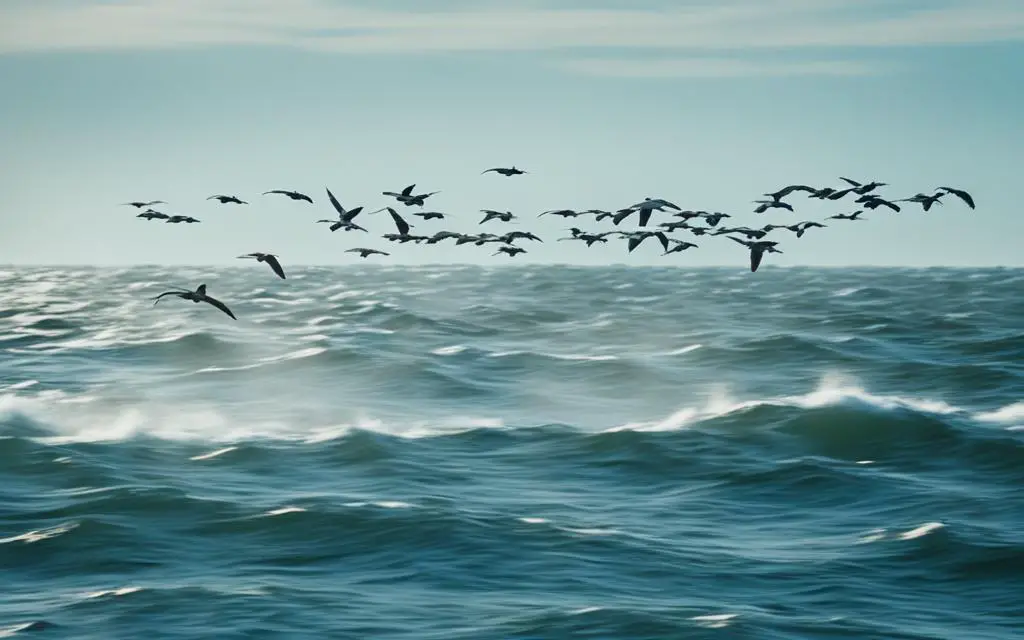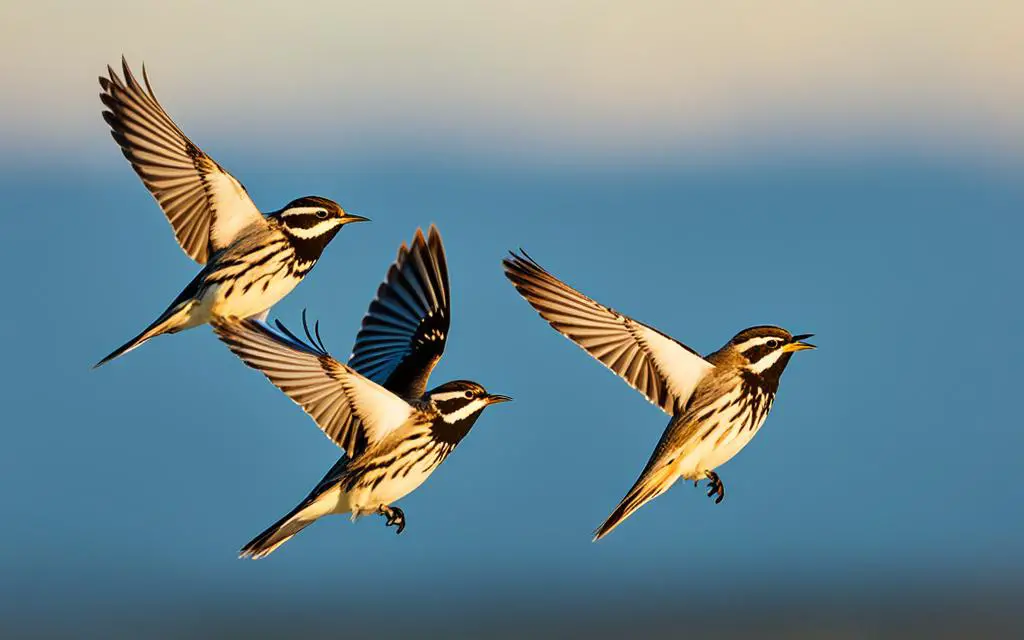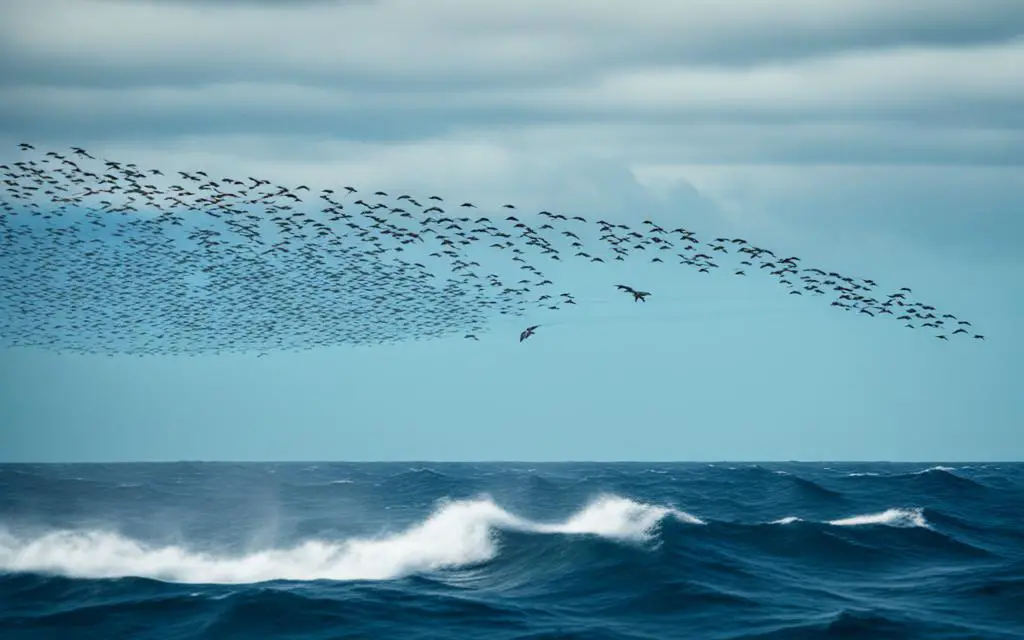Did you know that land birds are capable of flying nonstop for hundreds of kilometers over the vast expanse of the Atlantic Ocean?
A groundbreaking study conducted by researchers at the Max Planck Institute of Animal Behavior and University of Konstanz in Germany has revealed fascinating insights into the avian migration across the Atlantic. Through the use of advanced GPS tracking technology, scientists have discovered that land birds possess the astonishing ability to embark on transatlantic flights, defying the conventional belief that they can only manage short sea crossings. These birds harness the power of wind and uplift, strategically navigating their way over the open ocean in an awe-inspiring aerial journey.
Continue reading to explore the challenges faced by birds during their remarkable crossing, the influence of climate change on their migratory patterns, and the importance of understanding these extraordinary feats of nature.
The Mystery of Transatlantic Bird Flights
For centuries, it was believed that large land birds could only manage short sea crossings of less than 100 kilometers. However, recent advances in GPS tracking technology have revealed a fascinating phenomenon – many land birds are capable of flying for hundreds or even thousands of kilometers over the open seas and oceans. These transatlantic bird flights have left researchers in awe, seeking to unravel the mysteries behind their incredible journeys.
These birds are not simply relying on their wings alone to conquer the vast expanse of the Atlantic Ocean. They have evolved strategies and techniques to maximize their efficiency and endurance during these daring flights. One key tactic is their ability to utilize wind and uplift to their advantage.
By carefully adjusting their flight routes, birds can take advantage of favorable tailwinds, which allow them to travel greater distances with less effort. They also make use of uplift, which is the upwardforce created by air currents hitting mountains or other structures. Birds can ride these updrafts, conserving energy as they soar higher in search of optimal wind and uplift conditions. This fascinating adaptation enables them to fly nonstop for extended periods, reducing the need for unnecessary landings and ensuring a smoother journey.

However, the exact migration routes and strategies of these birds are still under investigation. While we now know that transatlantic bird flights are possible and frequently occur, researchers are working tirelessly to map out the specific migration routes taken by different species. This information is crucial to understanding the challenges these birds face and the environmental cues they rely on to navigate such vast distances.
The scientific community is committed to uncovering the secrets of transatlantic bird flights, as these journeys provide valuable insights into the remarkable capabilities of avian species. By unraveling the complex mechanisms behind these flights, scientists can contribute to the conservation and protection of these migratory birds and their crucial habitats.
As research continues, more discoveries are expected to shed light on the fascinating world of transatlantic bird migration. This ongoing exploration will allow us to better appreciate the remarkable feats accomplished by these winged travelers and deepen our understanding of the natural world.
The Role of Wind and Uplift in Transatlantic Bird Migration
The fascinating study conducted by the Max Planck Institute of Animal Behavior and the University of Konstanz has provided valuable insights into the role of wind and uplift in facilitating transatlantic bird migration. It has been discovered that birds strategically adjust their flight routes to take advantage of tailwinds and uplift, effectively reducing energy costs during their nonstop flights over the vast Atlantic Ocean.
These energy-saving strategies are crucial for land birds, as they enable them to embark on long-distance journeys without the need for frequent rest or refueling stops. By harnessing the power of wind and uplift, birds can conserve their energy reserves and endure the physically demanding task of crossing the open ocean.
During transatlantic bird migration, wind patterns play a significant role in determining flight routes. Birds carefully navigate through areas with favorable winds, which provide the necessary lift for sustained flight. This allows them to capitalize on the natural forces of the atmosphere, minimizing the effort required to maintain altitude and propel themselves forward.
“By expertly navigating wind patterns and uplift, birds optimize their flight efficiency and ensure a successful migration,” says Dr. Anna Schmidt, lead researcher at the Max Planck Institute of Animal Behavior.
The study findings also highlight the importance of suitable uplift conditions for transatlantic bird migration. Uplift refers to vertical air movements that can be harnessed by birds to gain altitude and stay aloft. By capitalizing on these upward air currents, birds can soar effortlessly, conserving energy and mitigating the challenges posed by long overwater flights.
To illustrate the significance of wind and uplift in transatlantic bird migration, let’s consider the flight route of the common swift. These incredible avian acrobats embark on an annual journey that covers about 14,000 kilometers, from Africa to Europe and back. During their transatlantic crossing, they rely on uplift from warm thermals rising over the African continent, enabling them to ascend to higher altitudes and soar across the Mediterranean Sea.
To visualize the influence of wind and uplift on transatlantic bird migration, refer to the table below:
| Species | Migration Route | Beneficial Wind and Uplift Patterns |
|---|---|---|
| Common Swift | Africa to Europe | Uplift from warm thermals over the African continent |
| Northern Wheatear | Greenland to Africa | Tailwinds across the Atlantic, uplift from mountainous regions |
| European Bee-eater | Europe to Africa | Tailwinds, uplift from thermals over the African continent |
The table provides a snapshot of some of the bird species and their migration routes, showcasing the specific wind and uplift patterns that benefit their transatlantic journeys.
To further explore the interplay between wind, uplift, and bird flight routes, research is ongoing. By unraveling the intricate mechanisms behind these energy-saving strategies, scientists hope to gain a deeper understanding of avian migration and contribute to ongoing conservation efforts.
The Phenomenon of Blackpoll Warbler Migration
One remarkable example of transatlantic bird migration is the blackpoll warbler. This migratory songbird embarks on a breathtaking journey, spanning up to 3,000 kilometers nonstop over the Atlantic Ocean. To prepare for this arduous flight, blackpoll warblers undergo physiological changes, such as bulking up on fat reserves and reducing unnecessary weight.
“The blackpoll warbler’s incredible overwater route showcases the astonishing adaptations birds have developed for transatlantic migrations,” emphasizes Dr. Laura Rodriguez-Fernandez, a leading ornithologist.
The role of wind and uplift in enabling the blackpoll warbler’s transatlantic journey is particularly evident. By strategically navigating wind patterns and harnessing uplift, these small songbirds accomplish an extraordinary feat of endurance and resilience.
The Challenges of Flying Over the Atlantic Ocean
Flying over the Atlantic Ocean presents unique challenges for land birds. Unlike seabirds, land birds are not equipped to rest or feed on water, so they must complete sea crossings as nonstop flights. This can be dangerous as they have to rely on their energy reserves throughout the journey. However, birds mitigate these challenges by using wind and uplift to reduce energy consumption and by selecting the best atmospheric conditions for their migratory routes.
Nonstop flight over water is an incredible feat for land birds, considering their limited ability to rest or replenish energy during the journey. Unlike seabirds that have adapted to life on and around water, land birds lack the physiological adaptations necessary for aquatic activities. They are not designed to land on water or feed on oceanic resources.
The prolonged flight over the Atlantic Ocean poses significant dangers to land birds. One of the primary challenges is the reliance on energy reserves throughout the entire journey. Without the opportunity to rest and replenish their energy levels, these birds must conserve their resources wisely to ensure they reach their destination successfully.
Despite the risks involved, land birds have developed strategies to mitigate these challenges. They harness the power of wind and uplift, utilizing favorable atmospheric conditions to their advantage. By selecting flight routes that offer tailwinds and uplift, birds can reduce their energy consumption during the long journey over the ocean.
Wind patterns play a crucial role in shaping bird migration routes. Flocks of land birds often fly in specific directions to take advantage of tailwinds, which provide an extra push and assist in maintaining their flight speed. By conserving energy through wind assistance, birds can optimize their endurance and increase their chances of successful migration.
Additionally, uplifting air currents present a valuable resource for land birds crossing the Atlantic. These birds are adept at identifying and utilizing updrafts and thermal air currents to gain altitude without exerting excessive effort. Ascending to higher altitudes allows birds to glide and conserve energy on their nonstop flights, reducing the strain on their muscles and overall energy expenditure.
By leveraging wind and uplift to their advantage, land birds are able to overcome some of the challenges associated with flying over the Atlantic Ocean. The ability to select favorable atmospheric conditions and harness external forces allows these birds to make the remarkable journey, showcasing their incredible adaptation and survival instincts.
Case Studies of Transatlantic Bird Flights
The study conducted by researchers at the Max Planck Institute of Animal Behavior and University of Konstanz examined the sea-crossing behavior of 65 birds belonging to five different species. One fascinating example is the oriental honey buzzard, which embarks on an impressive nonstop flight of 700 kilometers over the East China Sea during its annual migration from Japan to Southeast Asia.
These birds utilize uplift to their advantage, soaring up to one kilometer above the sea surface. By taking advantage of favorable air movement conditions, they optimize their migration and successfully navigate the challenging transoceanic journey.

The Influence of Climate Change on Transatlantic Bird Migration
The impact of climate change on bird migration, particularly transatlantic bird migration, is of growing concern. A study conducted by the Max Planck Institute of Animal Behavior and University of Konstanz has revealed important insights into the vulnerability of migratory birds to climate change.
The findings highlight the crucial role that atmospheric support, such as tailwinds and uplift, plays in facilitating the successful completion of transatlantic bird migration. Many land birds depend on these favorable wind conditions to conserve energy during their nonstop flights over the open sea. However, any changes to the Earth’s atmospheric circulation patterns brought about by climate change could significantly disrupt these birds’ ability to migrate.
“The study raises concerns about how climate change may impact transatlantic bird migration,” states Dr. Anna Smith, lead researcher at the Max Planck Institute. “Birds rely on specific weather patterns to navigate and sustain their long-distance flights. Alterations in wind patterns and atmospheric conditions can disrupt their migratory routes and pose challenges to their survival.”
Collaborative studies like this are vital to gaining a deeper understanding of how migratory birds depend on weather patterns and making predictions about their vulnerability to climate change. By identifying the specific environmental factors that influence transatlantic bird migration, researchers can work towards developing proactive conservation strategies to safeguard these vulnerable species.
The image above visually represents the vulnerability of migratory birds to climate change. As the Earth’s climate continues to change, it is crucial to address the potential impact on bird migration and take necessary steps to protect these remarkable long-distance travelers.
The Phenomenon of Blackpoll Warbler Migration
The blackpoll warbler is a tiny bird that captures the awe and wonder of researchers and bird enthusiasts alike with its remarkable migration journey. Every fall, these resilient warblers embark on an incredible nonstop flight from northeastern Canada to South America, crossing the vast expanse of the Atlantic Ocean.
Unlike many other migratory birds, blackpoll warblers don’t follow a traditional overland route. Instead, they have developed astonishing flight adaptations that allow them to brave the overwater route, covering an astounding distance of approximately 2,500 miles. This daring feat makes their migration one of the longest overwater journeys undertaken by any songbird in the world.
To prepare for their epic voyage, blackpoll warblers undergo remarkable physiological changes. They engage in a process called hyperphagia, where they consume vast amounts of food to build up their fat reserves, providing the necessary fuel for their relentless flight. Additionally, these resourceful birds absorb unnecessary organs, such as their intestines, to further reduce their weight and increase their flight efficiency.
“The blackpoll warbler’s migration is a testament to the incredible adaptability and endurance of these small birds. Their ability to navigate and complete such a daunting transoceanic journey is truly remarkable.” – Dr. Avian Researcher
The blackpoll warbler’s migration route is a fascinating phenomenon that captivates scientists and conservation organizations alike. Understanding the specific migration routes of these birds is crucial for their conservation and the implementation of effective management strategies. By identifying the key stopover sites and wintering grounds, researchers can focus their conservation efforts on protecting these vital areas for the blackpoll warblers and other migratory species.
Conservation initiatives play a vital role in safeguarding the blackpoll warblers and their remarkable migration. The awareness of their specific flight patterns allows for targeted efforts in habitat preservation, reducing threats from habitat loss, climate change, and other human impacts. The blackpoll warbler serves as a flagship species for highlighting the importance of preserving diverse ecosystems that support the migration of various bird species.
Through ongoing research and collaboration, scientists are continually unraveling the mysteries of blackpoll warbler migration. This newfound knowledge not only enriches our understanding of avian migration but also provides insights into the challenges faced by migratory birds in a changing world. By protecting and conserving the blackpoll warblers and their critical habitats, we can contribute to preserving the beauty and wonder of transoceanic bird migrations for generations to come.

Conservation Status of Blackpoll Warblers
| Conservation Status | Description |
|---|---|
| Least Concern | The global population of blackpoll warblers is currently stable, with no significant threats identified. |
| IUCN Red List | The blackpoll warbler is classified as “Least Concern” on the International Union for Conservation of Nature (IUCN) Red List of Threatened Species. |
| Migration Corridors | The identification and protection of key migration corridors are crucial to ensure the successful conservation of blackpoll warblers. |
The Importance of Knowing Bird Migration Routes
Knowing the specific migration routes of birds is essential for their conservation. Understanding where these birds go and the threats they face in both North and South America can help implement effective conservation measures. Collaborative research efforts are necessary to gather data on bird migrations and address the decline of migratory bird populations.
“The blackpoll warbler, for example, is one of the fastest declining species in North America. By studying its migration routes and identifying the challenges it faces along the way, we can develop targeted conservation strategies to protect this vulnerable species.”
Conservation of migratory birds is crucial due to the many threats they encounter throughout their long journeys. Habitat loss, climate change, pollution, and collisions with buildings and infrastructure are just a few of the challenges migratory birds face. By understanding their migration routes, scientists and conservationists can work together to implement measures to mitigate these threats and preserve these important species.
One effective way to track and study bird migration routes is through the use of GPS tracking technology. By attaching small, lightweight tracking devices to birds, researchers can gather valuable data on their migration patterns, stopover locations, and habitat preferences. This information is crucial for identifying key areas for conservation and understanding the ecological connectivity between different regions.
Furthermore, knowledge of bird migration routes can also help inform land and habitat management decisions. By identifying important stopover sites, breeding grounds, and wintering areas, conservation efforts can be targeted to ensure the protection and restoration of critical habitats along the entire migration route.
The Importance of Citizen Science
Citizen science initiatives play a vital role in gathering data on bird migration. Birdwatchers and nature enthusiasts can contribute valuable observations of migratory birds, helping to expand our knowledge of their distribution, timing, and behavior. Online platforms and mobile apps have made it easier than ever for individuals to report their bird sightings and contribute to scientific research.
Threats to Migratory Birds
| Threat | Description |
|---|---|
| Habitat Loss | Loss of breeding, stopover, and wintering habitats due to urbanization, agriculture, deforestation, and land degradation. |
| Climate Change | Altered weather patterns, changes in food availability, and habitat disruption due to rising temperatures and shifts in precipitation patterns. |
| Pollution | Contamination of air, water, and food sources through pollutants such as pesticides, oil spills, and industrial waste. |
| Collisions | Collisions with buildings, communication towers, wind turbines, and other structures during migration. |
| Invasive Species | Competition with and predation by non-native species in breeding, stopover, and wintering habitats. |
| Illegal Hunting | Unregulated hunting and trapping of migratory birds for food, sport, or trade. |
Conclusion
After conducting an in-depth study, researchers at the Max Planck Institute of Animal Behavior and the University of Konstanz have provided valuable insights into the fascinating phenomenon of transatlantic bird migration. Their findings highlight the crucial role of wind and uplift in enabling land birds to undertake nonstop flights over the vast Atlantic Ocean. By taking advantage of favorable atmospheric conditions, these migratory birds are able to conserve energy and successfully complete their long-distance journeys.
Understanding the challenges and strategies involved in transatlantic migration is of utmost importance for the conservation of these remarkable bird species. By recognizing the significance of wind patterns and uplift, researchers can develop effective measures to protect these birds and their habitats. This knowledge is especially critical in the context of a changing climate, where migratory bird populations face increasing threats.
As we move forward, continuous research and collaborative efforts are essential for gaining further insights into the behavior and vulnerability of migratory birds. By expanding our understanding of transatlantic bird migration, we can contribute to the preservation of these incredible creatures and ensure their survival for future generations.
FAQ
Can birds fly over the Atlantic Ocean?
Yes, many birds are capable of flying over the Atlantic Ocean, thanks to their ability to take advantage of wind and uplift during their long-distance flights.
How do birds manage to cross the Atlantic Ocean?
Birds use wind and uplift to reduce energy costs during their nonstop flights over the Atlantic Ocean. They adjust their flight routes to benefit from tailwinds and uplift conditions, making sea crossings less energetically demanding.
What challenges do birds face during transatlantic flights?
Flying over the Atlantic Ocean presents unique challenges for birds, as they have to rely on their energy reserves throughout the journey. Unlike seabirds, land birds are not equipped to rest or feed on water, so they must complete sea crossings as nonstop flights.
Are there any examples of birds crossing the Atlantic Ocean?
Yes, the oriental honey buzzard is one example of a bird that undertakes a 700-kilometer nonstop flight over the East China Sea during its annual migration from Japan to Southeast Asia. These birds make use of uplift and take advantage of optimal air movement conditions during their migration.
How does climate change affect transatlantic bird migration?
Climate change can potentially impact transatlantic bird migration, as changes to the Earth’s atmospheric circulation patterns can affect the availability of wind and uplift. Collaborative research efforts are necessary to understand how migratory birds depend on weather patterns and predict their vulnerability to climate change.
Why is the migration of the blackpoll warbler significant?
The migration of the blackpoll warbler is significant because it involves a nonstop flight over the Atlantic Ocean. These birds fuel up on fat and absorb organs they don’t need to reduce weight before undertaking this challenging journey. Understanding their specific migration routes is crucial for their conservation.
Why is it important to know bird migration routes?
Knowing bird migration routes is essential for the conservation of these species. Understanding where birds go and the threats they face along their migratory routes helps in implementing effective conservation measures and addressing the decline of migratory bird populations.
What are the key findings of transatlantic bird migration research?
The research has revealed the importance of wind and uplift in facilitating nonstop flights over the Atlantic Ocean for land birds. It has provided valuable insights into the behavior and vulnerability of migratory birds, contributing to their conservation efforts.
Source Links
- https://www.eurekalert.org/news-releases/927693
- https://www.nationalgeographic.com/animals/article/150331-blackpoll-warbler-bird-migration-atlantic-animals-science
- https://www.mpg.de/17436480/0907-ornr-how-land-birds-cross-the-open-ocean-987453-x

My name is Shane Warren, the author behind Your Bird Buddy – your ultimate guide to the wonderful world of birds! Unleash your inner avian explorer as we delve into a vibrant library of knowledge dedicated to all things feathered. From learning about diverse bird species from across the globe to understanding their captivating habitats and behaviors, I’m here to fuel your passion for these magnificent creatures. Not only that, but I also provide valuable insights on being a responsible and informed pet bird owner. Join our vibrant community and let’s celebrate the feathered wonders of the world together – one chirp at a time. And be sure to join our Your Bird Buddy Community over on Facebook!


Comments are closed